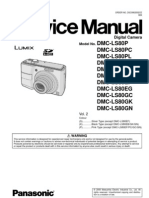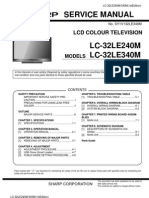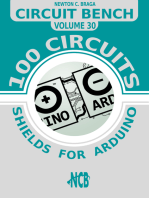POINT I/O Wiring Base Assembly: Environment and Enclosure
POINT I/O Wiring Base Assembly: Environment and Enclosure
Uploaded by
Thanh BaronCopyright:
Available Formats
POINT I/O Wiring Base Assembly: Environment and Enclosure
POINT I/O Wiring Base Assembly: Environment and Enclosure
Uploaded by
Thanh BaronOriginal Title
Copyright
Available Formats
Share this document
Did you find this document useful?
Is this content inappropriate?
Copyright:
Available Formats
POINT I/O Wiring Base Assembly: Environment and Enclosure
POINT I/O Wiring Base Assembly: Environment and Enclosure
Uploaded by
Thanh BaronCopyright:
Available Formats
General Attribute Signal terminal current, max Isolation voltage Value 1734-RTBS and 1734-RTB3S: 2A 250V, Basic Insulation
Type, field-side to system Type tested at 1000V AC for 60 s
Installation Instructions
POINT I/O Wiring Base Assembly
Catalog Numbers 1734-TBS, 1734-TB3S, 1734-RTBS, 1734-RTB3S Environment and Enclosure
ATTENTION
This equipment is intended for use in a Pollution Degree 2 industrial environment, in overvoltage Category II applications (as defined in IEC 60664-1), at altitudes up to 2000 m (6562 ft) without derating. This equipment is considered Group 1, Class A industrial equipment according to IEC/CISPR 11. Without appropriate precautions, there may be difficulties with electromagnetic compatibility in residential and other environments due to conducted and radiated disturbances. This equipment is supplied as open-type equipment. It must be mounted within an enclosure that is suitably designed for those specific environmental conditions that will be present and appropriately designed to prevent personal injury resulting from accessibility to live parts. The enclosure must have suitable flame-retardant properties to prevent or minimize the spread of flame, complying with a flame spread rating of 5VA, V2, V1, V0 (or equivalent) if non-metallic. The interior of the enclosure must be accessible only by the use of a tool. Subsequent sections of this publication may contain additional information regarding specific enclosure type ratings that are required to comply with certain product safety certifications. In addition to this publication, see: Industrial Automation Wiring and Grounding Guidelines, for additional installation requirements, Allen-Bradley publication 1770-4.1. NEMA Standards 250 and IEC 60529, as applicable, for explanations of the degrees of protection provided by different types of enclosure.
(1)
Use this conductor category information for planning conductor routing as described in Industrial Automation Wiring and Groundi ng Guidelines, publication 1770-4.1 .
Environmental Attribute Temperature, operating Value IEC 60068-2-1 (Test Ad, Operating Cold), IEC 60068-2-2 (Test Bd, Operating Dry Heat), IEC 60068-2-14 (Test Nb, Operating Thermal Shock): -2055 C (-4131 F) IEC 60068-2-1 (Test Ab, Unpackaged Non-operating Cold), IEC 60068-2-2 (Test Bb, Unpackaged Non-operating Dry Heat), IEC 60068-2-14 (Test Na, Unpackaged Non-operating Thermal Shock): -4085 C (-40185 F) IEC 60068-2-30 (Test Db, Unpackaged Damp Heat): 595% non-condensing IEC 60068-2-6 (Test Fc, Operating): 5 g @ 10500 Hz IEC 60068-2-27 (Test Ea, Unpackaged Shock): 30 g IEC 60068-2-27 (Test Ea, Unpackaged Shock): 50 g
Temperature, nonoperating
Relative humidity Vibration Shock, operating Shock, nonoperating
About the Assembly
DIN Rail Locking Screw (orange) RTB Removal Handle Mechanical Keying (orange) Removable Terminal Block (RTB)
Certifications (1734-TB3 and 1734-TB3S only) Certification (when product Value is marked)(1) c-UR-us CE UL Recognized Component Industrial Control Equipment, certified for US and Canada. See UL File E195367. European Union 2004/108/EC EMC Directive, compliant with: EN 61326-1; Meas./Control/Lab., Industrial Requirements EN 61000-6-2; Industrial Immunity EN 61000-6-4; Industrial Emissions EN 61131-2; Programmable Controllers (Clause 8, Zone A & B) European Union 2006/95/EC LVD, compliant with: EN 61131-2; Programmable Controllers (Clause 11) C-Tick Australian Radiocommunications Act, compliant with: AS/NZS CISPR11; Industrial Emissions
Interlocking Side Pieces
Mounting Base 1734-TB3 shown
44895
Prepare the wires
The total wire size range for the RTBs is 2214 AWG. The wire may be stranded or solid. ATTENTION
Do not use wire ferrules on wires connected to the terminals on the modules.
(1)
See the Product Certification link at http://www.ab.comfor Declaration of Conformity, Certificates, and other certification details.
Additional Resources
You can view or download publications at http://www.literature.rockwellautomation.com. To order paper copies of technical documentation, contact your local Rockwell Automation distributor or sales representative.
Strip Length
Wire Size Range, AWG 2214 AWG
Number of Wires 1 2
Strip Length 8-position RTB 161 mm (0.630.03 in) 181 mm (0.710.03 in) 12-position RTB 141 mm (0.550.03 in) 161 mm (0.630.03 in)
Publication 1734-IN013B-EN-P - June 2009
PN-49551
Copyright 2009 Rockwell Automation, Inc. All rights reserved. Printed in Singapore.
ATTENTION
Do not wire more than 2 conductors on any single terminal.
1. 2. 3.
Using a bladed screwdriver, rotate the keyswitch on the mounting base clockwise until the number required for the type of module being installed aligns with the notch in the base. Make certain the DIN rail locking screw is in the horizontal position. (You cannot insert the module if the locking mechanism is unlocked.) Insert the module straight down into the mounting base and press to secure. The module will lock into place.
Install the Mounting Base
To install the mounting base on the DIN rail, proceed as follows.
Install the Removable Terminal Block (RTB)
A removable terminal block is supplied with your wiring base assembly. To remove, pull up on the RTB handle. This allows the mounting base to be removed and replaced as necessary without removing any of the wiring. To reinsert the removable terminal block, proceed as follows. 1. Insert the end opposite the handle into the base unit. This end has a curved section that engages with the wiring base. 2. Rotate the terminal block into the wiring base until it locks itself in place. 3. If an I/O module is installed, snap the RTB handle into place on the module. Remove a Mounting Base To remove a mounting base, you must remove any installed module, and the module installed in the base to the right. Remove the removable terminal block (if wired). 1. Unlatch the RTB handle on the I/O module. 2. Pull on the RTB handle to remove the removable terminal block. 3. Press on the module lock on the top of the module. 4. Pull on the I/O module to remove from the base. 5. Repeat steps 1, 2, 3 and 4 for the module to the right. 6. Use a small bladed screwdriver to rotate the orange base locking screw to a vertical position. This releases the locking mechanism. 7. Then lift straight up to remove.
1. 2. 3. 4.
Position the mounting base vertically above the installed units (adapter, power supply or existing module. Slide the mounting base down allowing the interlocking side pieces to engage the adjacent module or adapter. Press firmly to seat the mounting base on the DIN rail. The mounting base will snap into place. To remove the mounting base from the DIN rail, remove the module, and use a small bladed screwdriver to rotate the base locking screw to a vertical position. This releases the locking mechanism. Then lift straight up to remove.
Install the I/O Module
The module can be installed before, or after base installation. Make sure that the mounting base is correctly keyed before installing the module into the mounting base. In addition, make sure the mounting base locking screw is positioned horizontal referenced to the base. 1734-MB
44896
Specifications
Turn the keyswitch to align the number with the notch. Notch position 3 is shown.
General Attribute Value
Field power bus supply voltage, 1734-TBS and 1734-TB3S: 300V max Field power bus supply current, 1734-TBS and 1734-TB3S: 10A max Dimensions (HxWxD), approx.
44009 Be sure the DIN-rail locking screw is in the horizontal position.
65 x 12 x 160 mm (2.56 x 0.472 x 6.25 in.) 0.34... 2.1 mm (22...14 AWG) solid or stranded copper wire rated at 75 C (167 F ) or greater, 1.2 mm (3/64 in.) insulation max. Dependent on installed module 1734-TB3 97.5 g (3.44 oz) 1734-TB3S 87.0 g (3.07 oz) 0.50.6 Nm (57 lb-in) None (open-style) 1734-RTBS: 300V 1734-RTB3S: 30V
Wire size Wiring category(1) Weight, approx. Terminal base screw torque Enclosure type rating Signal terminal voltage, max
You might also like
- Kariuki Ouma Ng'etich - Property Law Book - 2016Document518 pagesKariuki Ouma Ng'etich - Property Law Book - 2016Zakariya Mohamed82% (11)
- Share Vesting Agreement - ZegalDocument6 pagesShare Vesting Agreement - ZegalAlan PetzoldNo ratings yet
- Installation Instructions: POINT I/O Wiring Base AssemblyDocument2 pagesInstallation Instructions: POINT I/O Wiring Base Assemblydarwis_idNo ratings yet
- Devicenet 1732 Armorblock I/O, Series A: Installation InstructionsDocument16 pagesDevicenet 1732 Armorblock I/O, Series A: Installation InstructionsMariano DavicoNo ratings yet
- Controllogix Voltage/Current Input Module: Installation InstructionsDocument20 pagesControllogix Voltage/Current Input Module: Installation InstructionsMarco RojasNo ratings yet
- Ult REL Output Analog Modules 1734-In002 enDocument24 pagesUlt REL Output Analog Modules 1734-In002 enGabriel Constantin NastaseNo ratings yet
- Toshiba 32W2333D (G) Service ManualDocument90 pagesToshiba 32W2333D (G) Service ManualMichele Festa0% (1)
- POINT I/O Common Terminal Module and Voltage Terminal ModuleDocument16 pagesPOINT I/O Common Terminal Module and Voltage Terminal Moduleluisllumiquinga97No ratings yet
- 50l2333d Service ManualDocument58 pages50l2333d Service ManualPera KojotNo ratings yet
- 32L2333D (G) 32W2333D (G) : LCD Color TelevisionDocument26 pages32L2333D (G) 32W2333D (G) : LCD Color TelevisionrbtechnicNo ratings yet
- Lc-32le350m enDocument70 pagesLc-32le350m encandraNo ratings yet
- Service Manual: History Information For The Following ManualDocument56 pagesService Manual: History Information For The Following ManualMalanie Sriya De SilvaNo ratings yet
- 40L3433DGDocument27 pages40L3433DGDichter Dichter D0% (1)
- 6W Dual-Channel AF Power Amplifier: Package Dimensions FeaturesDocument10 pages6W Dual-Channel AF Power Amplifier: Package Dimensions FeaturesDanielNo ratings yet
- Phase Sequence Relays)Document8 pagesPhase Sequence Relays)sabrahimaNo ratings yet
- AB1734232 AscDocument24 pagesAB1734232 Ascgk6x4rvxrqNo ratings yet
- Inversor Abb 2 5kwDocument2 pagesInversor Abb 2 5kwapi-290643326No ratings yet
- LG L194WTDocument29 pagesLG L194WTqxbgwhvuNo ratings yet
- Phase-Sequence Phase-Loss Relay: K8AB-PH1-LDocument8 pagesPhase-Sequence Phase-Loss Relay: K8AB-PH1-LNguyễn Thanh QuangNo ratings yet
- Toshiba 40L1343DG, 40L1347DG Service Manual RarDocument27 pagesToshiba 40L1343DG, 40L1347DG Service Manual RarmariojulianrodriguezrodriguezNo ratings yet
- 1734 Oe2cDocument16 pages1734 Oe2ctony.pearce1No ratings yet
- 1734 Ie2vDocument16 pages1734 Ie2vtony.pearce1No ratings yet
- Manual Armoblock ABDocument24 pagesManual Armoblock ABJermy Abraham CarrascoNo ratings yet
- Micrologix™ Analog Input/Output: Installation InstructionsDocument24 pagesMicrologix™ Analog Input/Output: Installation InstructionsDavid LucioNo ratings yet
- LA4630NDocument9 pagesLA4630NekinetNo ratings yet
- Pioneer CDJ 800MK2.ServiceDocument114 pagesPioneer CDJ 800MK2.ServiceMAGAGAR0% (1)
- Service Manual: PhilipsDocument39 pagesService Manual: PhilipsRogerio E. SantoNo ratings yet
- Samsung Sv5000W-1 PDFDocument103 pagesSamsung Sv5000W-1 PDFsigi_204No ratings yet
- LG L1733TR L1933TR Monitor Service ManualDocument35 pagesLG L1733TR L1933TR Monitor Service Manualmanlu1001565No ratings yet
- Bu6010 GB 0300Document44 pagesBu6010 GB 0300Kadirou BigstarNo ratings yet
- LC-26P50E LC-32P50E LC-37P50E: Service ManualDocument91 pagesLC-26P50E LC-32P50E LC-37P50E: Service ManualShauna WhelanNo ratings yet
- DMC-LS80P Dmc-Ls80Pc Dmc-Ls80Pl DMC-LS80E Dmc-Ls80Eb Dmc-Ls80Ee Dmc-Ls80Ef Dmc-Ls80Eg Dmc-Ls80Gc Dmc-Ls80Gk Dmc-Ls80GnDocument41 pagesDMC-LS80P Dmc-Ls80Pc Dmc-Ls80Pl DMC-LS80E Dmc-Ls80Eb Dmc-Ls80Ee Dmc-Ls80Ef Dmc-Ls80Eg Dmc-Ls80Gc Dmc-Ls80Gk Dmc-Ls80GnRonal Gutierrez100% (1)
- L196WTQ-S, BFQ eDocument30 pagesL196WTQ-S, BFQ eadisistemsNo ratings yet
- Sharp 32le350mDocument70 pagesSharp 32le350mJorge Tom Simpson CruzNo ratings yet
- 1734 AENTR In040 - en P PDFDocument28 pages1734 AENTR In040 - en P PDFJair PinhoNo ratings yet
- DZB200M&JDocument41 pagesDZB200M&Jvijayrockz06No ratings yet
- Instruction Manual: Model 7SL High/Low LimitrolDocument48 pagesInstruction Manual: Model 7SL High/Low LimitrolkmpoulosNo ratings yet
- Sharp Lc-32le240m 340mDocument70 pagesSharp Lc-32le240m 340mDoru Razvan67% (3)
- 1734 VHSC5 PDocument24 pages1734 VHSC5 Ptony.pearce1No ratings yet
- 1746-Ib16 User ManualDocument48 pages1746-Ib16 User ManualC Raziel Fdz ONo ratings yet
- User Manual EG8245Q EG8247Q 4065149Document13 pagesUser Manual EG8245Q EG8247Q 4065149Claudio Carrasco NavarreteNo ratings yet
- 1500 Micro LogixDocument100 pages1500 Micro LogixMisael CastilloNo ratings yet
- Service ManualDocument36 pagesService ManualEu ToteuNo ratings yet
- Toshiba 32L4331D PDFDocument113 pagesToshiba 32L4331D PDFAndrés mNo ratings yet
- Model Paxlsg - Pax Lite Strain Gage Meter / Millivolt Meter: C Us Listed Us ListedDocument8 pagesModel Paxlsg - Pax Lite Strain Gage Meter / Millivolt Meter: C Us Listed Us ListedJosé Tomas CisnerosNo ratings yet
- Pioneer PDP 433PEDocument108 pagesPioneer PDP 433PEPaulo GardelNo ratings yet
- CT720g S774AAR5S2NCDocument45 pagesCT720g S774AAR5S2NCAnonymous CJnGHNNo ratings yet
- Man-1092 Synhro RepeterDocument12 pagesMan-1092 Synhro RepetersvirkomartinkoNo ratings yet
- Description of Hardware: February 00Document8 pagesDescription of Hardware: February 00Alex asherNo ratings yet
- QUASAR CODES 3140 - DTMF Telephone Relay Switcher: General Guidelines For Electronic Kits and Assembled ModulesDocument8 pagesQUASAR CODES 3140 - DTMF Telephone Relay Switcher: General Guidelines For Electronic Kits and Assembled ModulesNiamat KhanNo ratings yet
- Sony Kdl-32ex400Document56 pagesSony Kdl-32ex400Javi Veloso100% (1)
- Micrologix™ Analog Input/Output: Installation InstructionsDocument24 pagesMicrologix™ Analog Input/Output: Installation Instructionscamus1125No ratings yet
- Compact 32-Point Solid-State 24V DC Source Output Module: Installation InstructionsDocument24 pagesCompact 32-Point Solid-State 24V DC Source Output Module: Installation InstructionsThanh BaronNo ratings yet
- схема и сервис мануал на английском Toshiba 55L7453D PDFDocument375 pagesсхема и сервис мануал на английском Toshiba 55L7453D PDFАртём ДончуковNo ratings yet
- 7460 NewDocument8 pages7460 Newdumitrescu viorelNo ratings yet
- JVC mx-gt80 gt90 SM No-Sch (ET)Document48 pagesJVC mx-gt80 gt90 SM No-Sch (ET)Cliffton FilipinoPrd ShraderNo ratings yet
- On-Chip Electro-Static Discharge (ESD) Protection for Radio-Frequency Integrated CircuitsFrom EverandOn-Chip Electro-Static Discharge (ESD) Protection for Radio-Frequency Integrated CircuitsNo ratings yet
- Analog Dialogue Volume 46, Number 1: Analog Dialogue, #5From EverandAnalog Dialogue Volume 46, Number 1: Analog Dialogue, #5Rating: 5 out of 5 stars5/5 (1)
- Reference Guide To Useful Electronic Circuits And Circuit Design Techniques - Part 2From EverandReference Guide To Useful Electronic Circuits And Circuit Design Techniques - Part 2No ratings yet
- Digital LED Thermometer with Microcontroller AVR ATtiny13From EverandDigital LED Thermometer with Microcontroller AVR ATtiny13Rating: 5 out of 5 stars5/5 (1)
- FC300 Programming GuideDocument246 pagesFC300 Programming GuideThanh BaronNo ratings yet
- Bang Tinh Thep DamDocument42 pagesBang Tinh Thep DamThanh BaronNo ratings yet
- Technical Information Smartec S CLD134 PDFDocument20 pagesTechnical Information Smartec S CLD134 PDFThanh BaronNo ratings yet
- SEW Brakes: Service and MaintenanceDocument35 pagesSEW Brakes: Service and MaintenanceThanh BaronNo ratings yet
- European Guidelines Quality Criteria Computed Tomography Eur 16252Document114 pagesEuropean Guidelines Quality Criteria Computed Tomography Eur 16252Thanh BaronNo ratings yet
- 1756-Controllogix Common Procedures Programming GuideDocument575 pages1756-Controllogix Common Procedures Programming GuideThanh BaronNo ratings yet
- 5-DK Adult Health&FitnessDocument6 pages5-DK Adult Health&FitnessThanh Baron0% (1)
- CNC Programming WorkshopDocument150 pagesCNC Programming WorkshopThanh BaronNo ratings yet
- Manual Hardware FanucDocument445 pagesManual Hardware Fanuced_guaitolini2161100% (2)
- Exercise - FANUCDocument175 pagesExercise - FANUCsubbu.v1987100% (1)
- 22comm Um002 - en PDocument104 pages22comm Um002 - en PThanh BaronNo ratings yet
- Compact 32-Point Solid-State 24V DC Source Output Module: Installation InstructionsDocument24 pagesCompact 32-Point Solid-State 24V DC Source Output Module: Installation InstructionsThanh BaronNo ratings yet
- Flex I/O and Flex I/O-Xt ModulesDocument6 pagesFlex I/O and Flex I/O-Xt ModulesThanh BaronNo ratings yet
- 1769 DSI Modbus Comm ModuleDocument204 pages1769 DSI Modbus Comm ModuleThanh BaronNo ratings yet
- Automating With STEP7 in STL and SCL Hans - BergerDocument263 pagesAutomating With STEP7 in STL and SCL Hans - BergerThanh Baron100% (1)
- GROUP 2 ProjectDocument83 pagesGROUP 2 ProjectHemanth Krishna SheelamshettiNo ratings yet
- Army Vaccination Centres 2021-08-27Document2 pagesArmy Vaccination Centres 2021-08-27Adaderana OnlineNo ratings yet
- Service Layer Design: "Facade vs. Command"Document18 pagesService Layer Design: "Facade vs. Command"Virendra YadavNo ratings yet
- Shopping For Clothes: Conversation Cheat SheetDocument2 pagesShopping For Clothes: Conversation Cheat SheetAugustas IvanauskasNo ratings yet
- DC Motor Speed Control Using Arduino in ProteusDocument5 pagesDC Motor Speed Control Using Arduino in ProteusRamshaNo ratings yet
- 19 Ceramics 2nd YrDocument162 pages19 Ceramics 2nd YrLalit KumarNo ratings yet
- Non-Banking Financial InstitutionsDocument3 pagesNon-Banking Financial InstitutionsFarhan Ashraf SaadNo ratings yet
- Vascular Access and Infusion TherapyDocument47 pagesVascular Access and Infusion TherapyMaria Margarita100% (1)
- Literature Review Urban PlanningDocument6 pagesLiterature Review Urban Planningxwrcmecnd100% (2)
- VANSHIKA Statement of Purpose Curtin UniDocument2 pagesVANSHIKA Statement of Purpose Curtin Unibsaroj921No ratings yet
- Code of Commerce (Transpo) PDFDocument7 pagesCode of Commerce (Transpo) PDFmonmonmonmon21No ratings yet
- Indian Retailing Sector - Prospects and ChallengesDocument4 pagesIndian Retailing Sector - Prospects and Challengesijr_journalNo ratings yet
- Lesson Plan in English 7 NJCDocument6 pagesLesson Plan in English 7 NJCRomnia Grace DivinagraciaNo ratings yet
- Instructions For MMW ProjectsDocument2 pagesInstructions For MMW ProjectsChi De LeonNo ratings yet
- Spa Bir TransferDocument3 pagesSpa Bir TransferElamar de Leon100% (1)
- Crafter Panel Van-BrochureDocument49 pagesCrafter Panel Van-BrochureMircea PostolacheNo ratings yet
- Pengenalan Material Dan MetalurgiDocument3 pagesPengenalan Material Dan MetalurgiMugi MaulaNo ratings yet
- Mobile Division: Service Parts ListDocument20 pagesMobile Division: Service Parts Listlizbethdioses100% (5)
- Chapter 7: How To Construct A Questionnaire Lecture Notes: Johnson & Christensen Educational Research, 4eDocument12 pagesChapter 7: How To Construct A Questionnaire Lecture Notes: Johnson & Christensen Educational Research, 4eRowanChibiNo ratings yet
- Zanussi ZWY 61004 WA Washing MachineDocument36 pagesZanussi ZWY 61004 WA Washing MachineahmedNo ratings yet
- RTU Course "Construction of Machines and Mechanisms"Document2 pagesRTU Course "Construction of Machines and Mechanisms"Tibu BBNo ratings yet
- Attack Trees Are GraphicalDocument2 pagesAttack Trees Are GraphicalHồng ViệtNo ratings yet
- P020D-Fuel Injector 4 Performance: Theory of OperationDocument2 pagesP020D-Fuel Injector 4 Performance: Theory of OperationWillie AustineNo ratings yet
- Objective Type Question Bank (GATE and PSU)Document5 pagesObjective Type Question Bank (GATE and PSU)hytNo ratings yet
- Tiny Homes Beginners Guide To Smart Ideas of Tiny Homes in 400 Square Feet or Less by Berger, AndrewDocument90 pagesTiny Homes Beginners Guide To Smart Ideas of Tiny Homes in 400 Square Feet or Less by Berger, AndrewJosh RudnikNo ratings yet
- RFC 2142 DDDocument7 pagesRFC 2142 DDRam ChandiranNo ratings yet
- Estoppel Notice Michigan First Credit UnionDocument4 pagesEstoppel Notice Michigan First Credit Unionkingtbrown50No ratings yet
- Benefit Illustration: UIN: 104N116V04 Page 1 of 2Document2 pagesBenefit Illustration: UIN: 104N116V04 Page 1 of 2vivek0955158No ratings yet







































































































